Turquoise Energy News #153
covering
February
2021 (Posted March 2nd 2021)
Lawnhill BC Canada - by Craig Carmichael
www.TurquoiseEnergy.com
= www.ElectricCaik.com
= www.ElectricHubcap.com
Month
In
"Brief"
(Project Summaries etc.)
- Zincing battery cans - Outbuilding Siding
In
Passing
(Miscellaneous topics, editorial comments & opinionated rants)
- Gardening & Chickens - The Way Forward? Part 1 - Small
Thots (Food Sustainability; Progress and Longevity; Local Plastic
Recycling) - ESD
- Detailed
Project Reports
-
Electric
Transport - Electric Hubcap Motor Systems (No reports)
Other "Green"
Electric Equipment Projects (No reports)
Electricity Generation
* My Solar Power System: -
Monthly
Solar Production log et cetera
* Lithium-ion Battery Peculiarities
Electricity Storage
* Turquoise Battery Project
(NiMnOx-Zn in Mixed Alkali-Salt electrolyte)
- Making New Cylindrical Cell - Trying to plate copper cans with
zinc
I'll start by apologizing for the quality of the images.
My new cellfone's camera isn't as good as the old one. In particular
close-ups are pathetic. (My land line # is 2505597735.)
Somehow everything keeps taking much too long. I tried a
few things to get a zinc plating on the inside surface of the copper
battery cans, but I didn't find anything very satisfactory, except
tedious brush plating seemed to eventually make a good surface. Even
that looked better on a flat piece of copper than inside the cans.
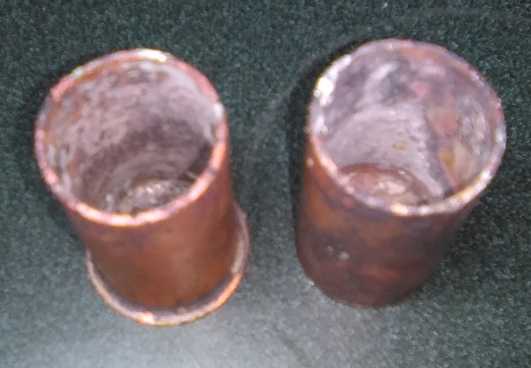 Zinc melted and poured into the cans, then
poured out, didn't coat very well.
Zinc melted and poured into the cans, then
poured out, didn't coat very well.
Probably my technique - and my flux - could be improved?
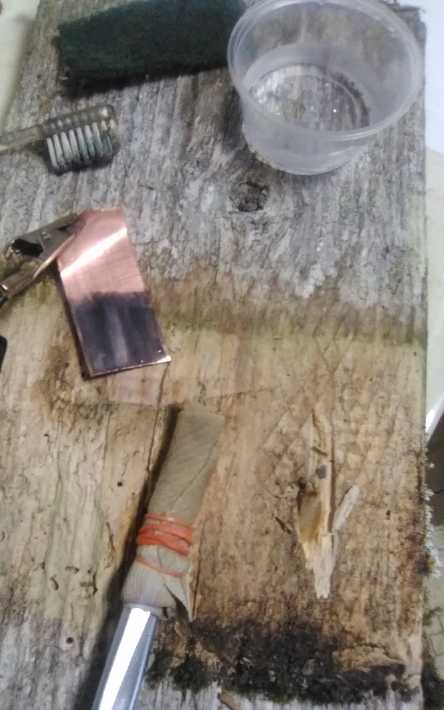
Brush electroplating with a zinc wand and zinc chloride electrolyte
worked well
on a flat piece of copper sheet, but it took a long time to build up
any thickness
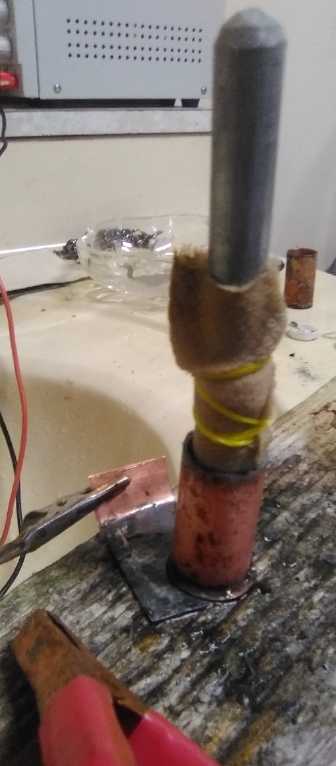 Zinc rod "wand" in the can; can on copper sheet
for
Zinc rod "wand" in the can; can on copper sheet
for
electrical contact as I rotated it for an even coating.
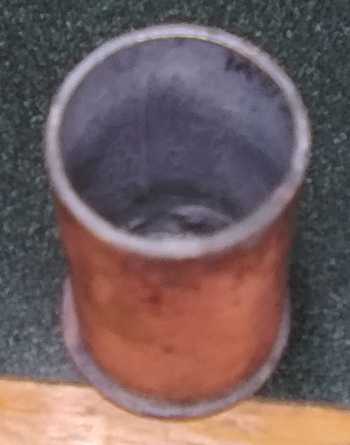 It took quite a while to get any thickness of
It took quite a while to get any thickness of
zinc plating in the can wall.
I may go at it for another hour or two to deposit
enough zinc for a couple of amp-hours of capacity.
The need to find a better way is obvious. Peter suggested
dipping open copper pipes and then soldering a bottom on the can with
regular tin solder. I suspect that will dissolve and leak when the cell
is in use, but I could be wrong. No doubt I should try it. He also
suggested making plastic bottoms. I have the same reservation about
probable leaks, but again it's something simple to try. (It the plastic
top leaks at least vapor will come out instead of liquid.)
I meant again to do the ground effect model wiring to the
microcontroller sometime during the month, but didn't. (Maybe
in the next day or two? And then try out the programming?) Other than
rewiring the solar panels on the outbuilding roof that was about it for
energy projects, and that was simply a change necessitated in the
process of putting up siding as I had originally just run the wires
through a hole in the wall.
Part of my outbuilding (maybe I'll call it "the cottage"?)
wall's aluminum siding had to be disassembled and redone as the top
didn't align with the bottom at the far side of the window. Even this
wasn't done until near the end of the month. On the last day [28th] I
had got just over half way, delayed by re-routing the solar panel
wiring. I had just run it over the edge and through a hole in the wall
near the peak.
I drilled a hole under the ridge cap, next to the peaks
and just inside the wall, and put the wires through that. In that
process I had to unscrew the ridge cap, and to do that I had to take
one solar panel off and undo 3 of the 4 lag bolts on the next one.
While everything was disconnected and the relevant section of the ridge
cap shoved to one side, the loose panel decided to slide slowly off the
roof. I couldn't reach it in time. I waited for the crash, but it
landed in the moss and didn't break. Yay! I put it back up and got
everything re-assembled. It looked like if these panels hadn't been
disconnected for a couple of hours, the day's energy collected might
have exceeded 6 KWH for the first time this year. The next day it did,
just barely.
As can just be seen just under the peak, the center three
pieces weren't quite long enough. I may put up a piece of sheet
metal to keep the wind from blowing rain in. The rest of the siding to
the right has no more special interruptions so it should go on
pretty quickly and smoothly. (Then there's framing in the window.)
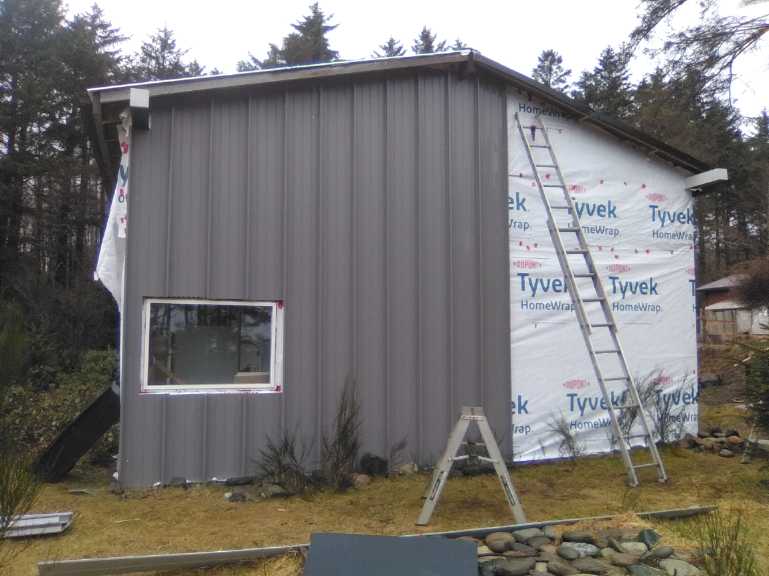 State of the aluminum siding project at the end
of February
State of the aluminum siding project at the end
of February
The cottage should look pretty nice if it's ever finished
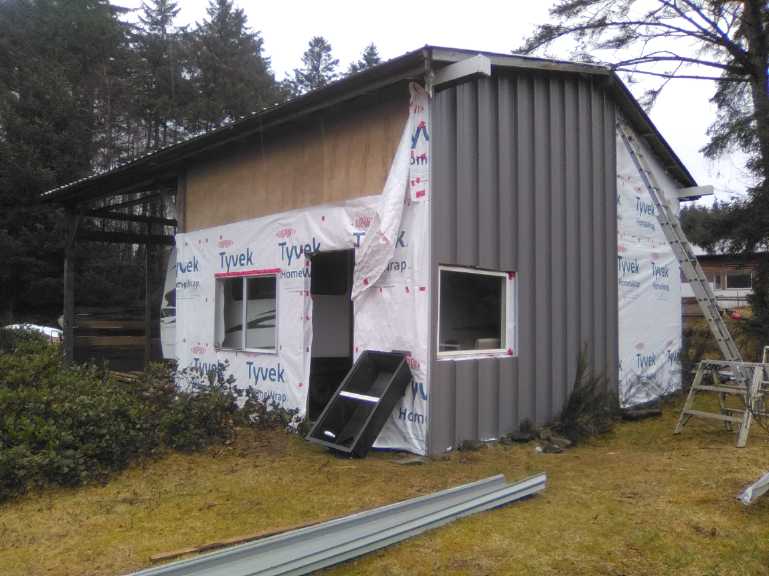 I really do need to get this done. Tyvek is
just polyethylene, which deteriorates in sunlight
I really do need to get this done. Tyvek is
just polyethylene, which deteriorates in sunlight
and the staples keep getting ripped out in the wind, and the thin
plywood is getting rained on.
Putting the door on that corner would be great too, even if the
structure is still only 1/3 enclosed.
The right (East) wall gets the wind blowing against it, whereas the
left (South) wall often
is in the lee, so the tyvek is pushed against the one wall but sucked
away from the other,
and all the staples have ripped out of the upper piece.
In Passing
(Miscellaneous topics, editorial comments & opinionated rants)
Gardening
&
Chickens
In January I booted the chickens out of the garden plot,
intending to move them to another area I could easily fence in, but
they
didn't seem to want to go to that area. Instead they took to roaming
around other parts of the yard, and roosting in my new carport. This
seemed okay to me but one vanished, and somewhere around the start of
February a hawk (must have been a hawk) killed three more. Probably it
was all a hawk. With nowhere
else safe, I took to herding them into the garage each night. After
much resistance on the
first night they went in willingly as dark approached. Turning the
light on seemed to make them the more willing. I was not however at all
happy with having to turn on the light, get them in, shut the door,
wait an hour for them to settle down, and then turn the light off
again. And
then let them out in the morning. I was even less happy with them
knocking everything off the cluttered shelves and pooping on
everything. It'll be a long time before the cleanup is completely
finished.
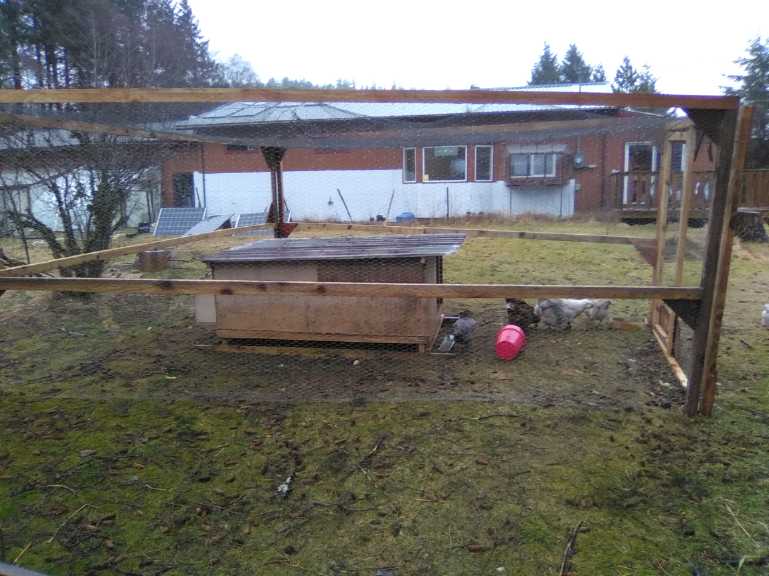 So once again a construction project took priority. The
cold weather made difficulties and delays. But finally I had made up
three wooden frames with chicken wire, 16 feet long by 6-1/2 feet tall,
with hooks on one end and eyes on the other. Thus they could be
assembled into a triangular fenced-in area. It was of course hard to
get in and out of.
So once again a construction project took priority. The
cold weather made difficulties and delays. But finally I had made up
three wooden frames with chicken wire, 16 feet long by 6-1/2 feet tall,
with hooks on one end and eyes on the other. Thus they could be
assembled into a triangular fenced-in area. It was of course hard to
get in and out of.
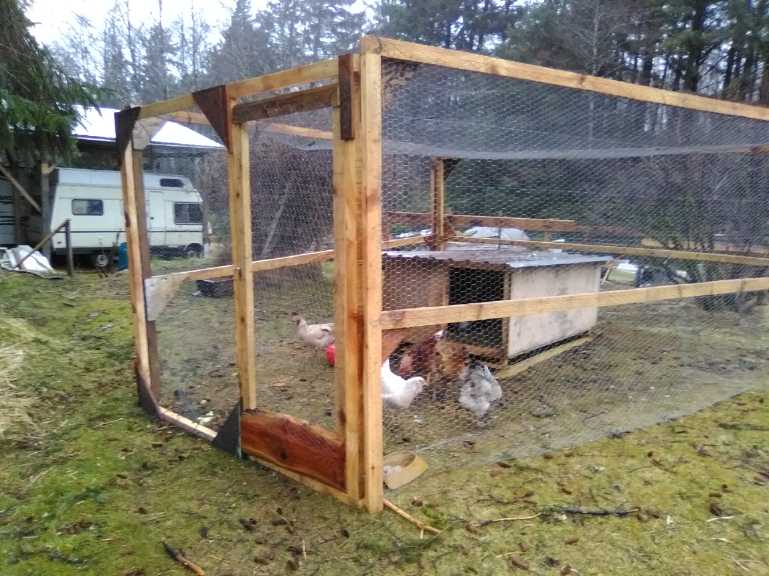 Next I made a short fourth side with a door in it. The
door having pins rather than hinges opens in either direction. Then I
did some more work on the 1/2 finished
chicken coop and by the 23rd had 2 nesting boxes on one end. (Still no
proper door! I have to unscrew a plywood wall to gain good access for
cleaning etc.)
Next I made a short fourth side with a door in it. The
door having pins rather than hinges opens in either direction. Then I
did some more work on the 1/2 finished
chicken coop and by the 23rd had 2 nesting boxes on one end. (Still no
proper door! I have to unscrew a plywood wall to gain good access for
cleaning etc.)
With the light having been on in the garage for a couple
of hours each evening, the chickens, or some of them, started laying
eggs. As the daylight gets longer the five hens should be laying about
3 to 5 a day without additional light. On the 27th I took 18 to the
farmers' market intending to have friends sell them for me for the
going rate of 7$/dozen. But they weren't there: Fear of CoViD. So I got
a billboard to put it out by the highway at my driveway during
"business hours". ("Green Eggs - no ham.") And "Solar Panels &
Equipment" while I was at it. I hope the money will be more than the
feed is costing. (No takers on the first 2 days.) My original idea of
having a hen or two eating off the land doesn't seem to have come to
pass. Between them all they're eating much more grain than I do.
There wasn't much other
gardening. I have some "other variety" apple and pear scions to try
grafting to my non-productive fruit trees. It's just about the right
time according to videos on the subject. I got quite a lot of
blueberries last year off two little bushes. (A third bush looked dead.
It came back to life but with no flowers or fruit for the year.) So I
bought two more. And somebody gave me two "josta" bushes - said to be a
cross between red currants and gooseberries, to plant somewhere.
The
Way
Forward?
-
Part
1
"You never change things by fighting the existing
reality.
To change something, build a new model that makes the existing model
obsolete."
- R. Buckminster Fuller
This is truly a profound statement. Demonstrations and
protests may have some temporary effects, but are essentially negative.
To change whatever is really wrong one must first determine the
underlying cause, the malady that is creating the symptoms that are
being protested. And that something is often so "taken for granted"
that it is considered to be "a given". No one involved on any side of
the problem even thinks about changing it. All feel helpless to affect
the object of protest in a better way from where they are and the
result is confrontation instead of a cooperative solution. The very
fact of a "protest" means there was nothing more productive that
citizens - or government - could do from within the existing model. A
fundamentally new way of doing something is required. There is no real,
permanent solution for the problem until the "given" is changed, until
there is a new model for doing whatever it is.
In the present model of society we have "object oriented"
organizations that are supposed to work toward specific objects. As the
decades have passed, more and more these objects have primarily become
increasing their own prestige, power and influence - and usually making
a monetary profit or gaining a larger budget - almost regardless of
society's original intention for forming that organization, harm to
anyone else or to
society as a whole. Not only the executives but often going down even
to the workers at the ground levels, people have bought into these
separating, divisive orientations to the point that society as a whole
has been broken up into competing factions. Thus originally small
cancers have metastasized into chaotic destructive forces. In many ways
there is no more Canada, no more USA.
Just divided and divisive factions, none of them working for the
maintenance or furtherance
of society, the nation or culture. We have already collapsed internally
and in our patterns of thinking, and without better models we just
await some critical moment for this collapse to become outwardly
obvious.
We can see the effects in economics, education,
health and especially in finance and government. In politics an
oligarchy has grown to be
everything. Democracy and the rights and liberty of the citizens to
lead their own lives protected by the rule of law are only
tolerated as far as they don't interfere with the "empire building" of
the oligarchs. In this new millenium we have increasingly seen
political figures thrust forward who are just puppets for the
oligarchs. Choice is "Tweedledum" or "Tweedledee", both puppets
pre-approved by the same unelected, publicly unaccountable people. Like
the current US president, they have few particular thoughts of their
own and no morality but simply to sign whatever is placed before them
by these "powers that be" behind the scenes.
In economics the jobs have been moved to wherever the
workers
are least demanding and most desperate, to the point where formerly
affluent societies have essentially been shut out of production,
reducing the whole world to the status of the least. (This isn't
entirely negative as the status of many of "the least" - at least those
where the jobs have moved to - has risen. OTOH, as the population has
continued to grow, everyone's quality of life has suffered everywhere.)
In education, children are taught to obey the
authoritarian
powers because they supposedly "know better" than everyone else,
instead of being taught the critical
thinking and other skills so necessary to making them self sustaining
adults and the leaders and contributors of tomorrow.
In "health", profit ranks far above health and wellbeing.
We have phenomena
such as continued "CoViD" illness and death while the cheap, safe and
well known pill Ivermectin that should have ended it is kept from
public knowledge and out of everyone's hands. Much of the "third world"
has ended CoViD as a serious concern with Ivermectin. (Romania is just
now the first European country getting Ivermectin into the drug stores.
Although it is said to be easy to produce, the demand has been much
greater than the supply.) Much that is well
known about preventing and treating cancers is likewise not taught or
suggested to the public. (eg: Far too many people don't know that 1000
I.U. of vitamin D daily will cut your chance of cancers in half -
probably more than in half in climates that don't favor going out in
the sun very often. And no one in medical authority cares to tell us
that.) And the new US administration has approved a huge increase in
the price of insulin to diabetics in the midst of the economic meltdown.
In finance, those who know how to use and leverage money
to
their own ends are now receiving most of the "free" newly printed money
as well as being adept at relieving the innocent of theirs. It is
reaching the point of outright looting of anyone "not of privilege" who
hasn't planned their strategy carefully or who is unfortunate enough to
get into a poor position or to get in "someone's" way. Thus we
have a wealth disparity that now far exceeds that of feudal times.
So in essence, there is no "nation" or "society" any more.
No Canada or USA,
only divisive factions. Nowhere or by anyone or any organization is the
good of the whole being taken into consideration. Few identify
themselves as "Canadians" or "Americans" (et cetera) any more. That
category
is too broad, conflicted and seemingly academic.
Thus we are at the place where our civilization is ready
to
break down just like every past civilization on this planet, except
this time it's pretty much global. It is
already broken internally. That can't be corrected by any number of
quick fixes and tweaks to the
existing ways of doing things - even if the will to fix things was
really there in some of the organized bodies. In the end the cheap
fixes will all be in vain.
When the outward collapse occurs, we must note that (as in for example
in the Soviet Union) there has already been an inward collapse. 20th
century democratic civilization is poised to go the way of
ancient Egypt, Greece,
Rome, the Incas, the Han dynasty and all the rest.
Or, better... where are the new models? They need to be
conceived and adopted.
As Fuller says, we need new models that will eclipse the
old ones rather than fight them. One that will render them obsolete. In
the overall
picture, we need to replace our "object oriented" institutions with
"values oriented" ones, and the values explicitly espoused in their
charters have to be the core values of being human*.
Object orientation shows up in thinking of each human as
"one among many". Values orientation views each individual having value
where he may be seen as a small or large contributor to family, society
and humanity, in many different ways. Equality in Spirit is not
uniformity of physique, talents, or intellectual perspective or
capacity. Apples aren't oranges.
For a visible example, one person may be a better national
president than another. Few would accept that it doesn't matter who
gets that job. The one who isn't as good at that may excel at other
things and in a broad view either or both may be greater or smaller
contributors. Still another person might never be known to the public
yet his quiet contributions may be of great value to society. Young
peoples' value is mostly potential; it lies in the future. An elder may
have already contributed great value, and may have still more to offer
in the way of wisdom and insights.
We need to discern the value and the values, present and
potential, of people and organizations, not merely observe their
existence as entities.
Well, identifying the problem is the first step in
correcting it. Next month I hope to present some better models in a way
that can be easily understood. For that I need to do some study myself.
---
* At the risk of sounding like a broken record, the core values of
being human are being taught as:
- Life
- Equality (equal consideration for each individual including oneself)
- Quality of Life
- Growth (living is growing!)
- Empathy
- Compassion
- Love (in general terms, for existence and for all humanity)
One expects that people all over the world in every
culture and society will agree on the primal value of Life and the next
three, and will recognize that those things won't be attained and
sustained without the last three "secondary" core values.
(There is a web site: 7CoreValues.org)
Small
Thots
Food Sustainability
* "Epic Economist" on youtube says that not only finance and economy
but the systems that support life on Earth are all reaching a
"saturation point" and starting to irreversibly collapse. (The
"Everything Collapse" Continues: One Third of all Freshwater Fish [species]
are Facing Extinction -- Epic Economist, February 24th 2021)
Freshwater fish are the "canaries in the coal mine" for our global
ecology.
He might be overstating the case if considered over any
short time period. Taken over years and perhaps decades however, we are
definitely headed in the direction of disaster. But many species are
going extinct before our eyes. Hopefully we change course and the
population is reduced before "irreversible collapse" occurs. How many
can we preserve, and how, until nature gets a reprieve? In the "great
depression" of the 1930s game animals became scarce in America. Now
there are three times as many people. Will deer, elk, moose and bison
be gone forever like the mammoth, mastodon, glyptodont, and the Shasta
ground sloth that our ancestors hunted? How can we save them for the
future if masses of people are hungry?
* As I have noted before, we are strip mining the Earth to sustain the
present population bubble. We are fishing out the oceans. Presently
other countries have started sinking Chinese boats illegally fishing in
their waters. The Chinese food shortages are real.
Our agriculture is even less sustainable than I previously
realized. Of the three main "NPK" fertilizers making fields produce
more product, both phosphorus ("P") and potassium ("K") compounds are
being mined from underground. Phosphorus especially is now getting
scarcer and more costly by the year. We are farming to the limit and
the fields we are farming are about to become less productive.
* Some say if we stop eating meat and eat only plant products, we could
free up the land being used for grazing and grow more vegetable crops.
While it sounds logical, there are flaws in this argument. The American
plains were made fertile with deep topsoil by the buffalo (bison)
grazing them. And the land now being used for ranching is that which
for one reason or another isn't very suitable for growing crops. So
eliminating cattle won't give us much more in the way of other foods,
it will only deprive us of beef and other meats.
* A video tells of the miracle of re-introducing wolves into
Yellowstone national park some decades back. By hunting the deer and
keeping them on their toes (hoofs?), the deer population has been much
reduced. This has led to an explosion of other life. New forests and
meadows have sprung up with more plants and more variety, which support
more
insects, and species of birds and animals which had vanished are moving
back in. This includes beavers, which have stabilized rivers and
retained more moisture for dry times.
It seems to me that deer and sheep, if allowed to
overpopulate, are prime causes of land degradation, desertification and
habitat destruction. There's a good reason that when there were no
fences, the cattlemen hated the sheep herders. Like the buffalos, the
cattle only browse the grass short. Too many sheep eat right down to
the
roots and wreck the pasture. An overpopulation of deer trim off all the
undergrowth and sapling trees, eliminating many species and preventing
forests from regrowing.
Progress and Longevity
* The first Isaiah seemed to have been gifted with a vision of the
distant future
when he wrote: [Isaiah 65; "New Heavens and a New Earth"]
[20] "Never again will there be in it an infant who lives but a few
days, or an old man who does not live out his years. He who dies at 100
will be thought a mere youth; he who fails to reach 100 will be
considered accursed."
[21] "They will build houses and dwell in them, they will plant
vineyards and eat their fruit."
[22] "No longer will they build houses and others live in them, or
plant and others eat. for as the days of a tree, so will be the days of
my people. My chosen ones will long enjoy the works of their hands.
[23] "They will not toil in vain or bear children doomed to misfortune,
for they will be a people blessed by the lord, they and their
descendants with them."
(My bible-studying biochemist brother, also interested in
aging and longevity, pointed me to this. I read the Old Testament once,
decades
ago. While there was much that I might term "dross", I did think there
were some good things in it, especially in Proverbs and Psalms.)
[Note: According to The Urantia Book there were two prophets named
Isiah, the second of whose writings were incorporated into those of the
first as sections 40 to 55.]
His vision is still in the future but getting much closer
than in his day. Advances in sciences, medicine, technology and living
standards are bringing us there by the decade, in a few centuries. A
friend died of a sudden heart problem in 2000. Another in 2014 was
saved. The doctor told him he would be fine, but "Ten years ago we
would have been telling you to wrap up your affairs."
There are however some social problems that badly need to
be
solved today. A few people now own most everything. The fruits of
everyone's labor are going to the 1% of the 1%.
Life expectancies have been rising and except where
calamitous conditions arise and they may soon exceed 100 years. Living
to 200 or 300, reaping the fruits of one's own labors and investments
and other parts of Isaiah's vision seem farther off. But a drop in
population freeing up land and making it a poor buy for "investment",
might alter the picture considerably within a generation.
* Some dystopian idea of a "financial reset" (or is it an "everything
reset"?) is that "by 2030 you will own nothing and you will be happy!"
The very phrasing of this idea is itself a big red flag. It's not "We
will all", it's "You will". Where is the first core value of being
human, Equality? At face value it sounds like a serious threat by
oligarchy to
revert society to feudal times.
What are the new terms by which land use (and usage of all
goods and services is implied?) will be regulated besides "private
ownership"? What sort of public oversight ensures fairness for all --
at a
time when
we are seeing public control over anything and everything being usurped
by oligarchs?
It is theoretically possible to go beyond private
ownership in just and equitable ways. Probably there are multiple ways
to do it. After all, we all live and die and we can never take any
material thing with us when we leave. As an example, assuming
reliability, responsible
drivers (or especially with "self driving" vehicles if they become
reliable enough), and an entity responsible for maintenance and upkeep,
it may be entirely possible to eliminate private ownership of vehicles,
especially in urban areas, to the advantage of those who now have to
own and maintain a vehicle for their transportation and cargo needs.
But for land and housing there are societal conditions
that have to be met first, and having a small greedy minority trying to
abscond with far more than they have the slightest use for is inimical
to being able to create a sustainable system. Bill Gates for example
now owns more farmland than anyone else in the USA. Surely this has
driven land prices up, even while farmers are going bankrupt
(apparently
in the millions) with high costs causing high debt loads and and then a
couple of years of disastrous
harvests. Gates is not a farmer. Is he planning to rent out the land to
those who would like to farm but can't afford to buy farmland - or even
keep what they own - when so much is being hoarded? (I
understand the
average age of farmers, over 50 a decade ago, is now over 60. The well
established - even
multi-generational farms and ranches - can barely make ends meet if at
all; young people can't afford to start.)
* Now apparently the new administration has a plan for taxing
"unrealized capital gains". At face value that means when you inherit
the family farm, you have to pay tax on the increase in price of the
land. For example if your grandfather bought the land for $25 per acre
way back when, and it could now sell for $1000 per acre, when you
inherit it you have to pay income tax on $975 per acre. So for say 160
acreas (a quartersection), you would be paying income tax on 156,000 $
of income you didn't make - maybe 60-70 thousand dollars? Other than
what value was added to the land by the family's own labor over time,
the land is
the same. So it's a tax on the inflation of the money supply over a
long period of time, which of course means the original purchase price
is
trivial in today's inflated currency. There's usually only one way to
come up with a huge amount of
money at once: you are forced to sell the family farm. You can't
inherit it. (Bill Gates will buy it?)
* Predictably the new administration is quickly making itself
unpopular, with dozens of radical executive orders signed even in its
first day, including draconian new "CoViD" rules for air travelers and
yet throwing the whole southern border wide open to the caravans,
floods of migrants who think they might find a better life in a
country now being overrun by themselves with no enculturation or
support. (They're looking for "11 million new citizens" - unintegrated
mouths to feed and house - in a dying economy where
unemployment, homelessness, poverty and hunger are already rampant and
spreading
rapidly) And dangerous warmongering in the middle east. And there's to
be yet more curtailment of personal liberties and business activities
"in the name of CoViD" - destroying an already destroyed economy. Even
higher prices for medications such as insulin for an increasingly
destitute public.
Increasingly critical and vocal opposition on various
fronts, already taking action in the courts, will surely cause a
violent gut reaction from those who now have total control. A firestorm
is surely brewing.
* Someone says that US senator Elizabeth Warren, after her
interrogation and criticism of the banking system after the 2008 crash,
said she
was told then: "You can be on the outside, but no one will listen to
you, or you can be on the inside. But one rule for being on the inside
is that insiders never criticize each other." Is that why we so rarely
hear of scandals - or anything the least bit negative - in or about the
inner circles of US government?
* The New York Times has printed an issue detailing some of the various
unscrupulous ways the US federal elections were "saved" (from the will
of the people), steps that "were necessary" to "preserve democracy" in
the USA. Does that sound to anyone else remarkably like the sort of
"doublespeak" from George Orwell's dystopian novel, 1984?
* I had wondered why people had kept re-electing the same governor in
California for so long in spite of the things he had done. (How can a
government "lose" 100,000 petition signatures so there aren't quite
enough to cause an initiative/referendum to be placed on the ballot?)
(Hmm... What was his name again?) Now people are upset with the new
governor, Gavin Newsom (SP?) and some are gathering signatures to try
to get him "recalled". In connection with the 2020 federal election
someone claimed in a youtube comment that Califoria elections have been
rigged for ages. Someone else said that Newsom is Nancy Pelosi's
nephew. Suddenly things started adding up! Could it really be?
California elections are rigged?!? Oligarchy, corruption, greed,
nepotism by a "privileged class"?... is some new form of "monarchy"
being foisted on an unsuspecting public?
* The Co-op grocery here has stopped using plastic bags. They ran out
of
paper bags and even polypropylene cloth bags for sale at one point a
couple of months ago - everything was on back order. People, seemingly
mostly the
Haida, started taking the shopping baskets home with their groceries --
and not bringing them back. What result did they expect to achieve
besides that there are now no shopping baskets available? One must
now either hold their groceries in their arms or get a shopping cart
even
for a few things. A whiteboard in the doorway requests that people
return the baskets, but they are not being returned. (It's a good thing
shopping carts don't easily fit into cars!)
It is scary that there are enough people who feel so
"entitled" that this would happen on this small island. What will it be
like when things get rough? What will it be like in big cities?
* Economies of Scale: The large producer has advantages of the
economies of scale over the small. The biggest one is being able to
hire specialty workers for various jobs as a very small percentage of
the total labor cost, which are difficult or uneconomic to the small
producer. These would include (a) doing the burdensome government
paperwork and accounting (b) running PR and advertising campaigns to
denigrate small producers - to convince people that your cows' milk and
chickens' eggs are somehow better and safer than those from small
producers. (c) working to find ways to hamper and embarrass the
operations of the small producers. (d) lobbying government to change
various laws to subtly or overtly favor your large business over these
"inferior and unreliable" small producers, and even get them shut down
for public safety.
* Texas Cold and Snow: Here on the BC north coast somewhat
south of
Alaska, we have had temperatures down to around -5°c this month.
Far, far to the south and east, Texas has had similar temperatures (and
even some considerably colder). There are however some vast
differences: Texas sub-freezing cold has persisted longer, there's been
a lot of snow, and mainly, in an area with normally mild to hot
weather, people and institutions are totally unprepared. There are no
snow plows - or even snow tires. No one has firewood stored up. No one
has emergency heat. Why should water and gas lines be well buried? Why
would they expect huge electrical demand? Pipes burst and
water, power and gas was off in many areas. The independent Texas power
grid was overwhelmed and with many gas fired generators (40%) as well
as
solar and wind generation (10%) off line.
Thus a cold snap here isn't unexpected and hasn't caught
people unprepared, but is a disaster in Texas. Most services have been
overwhelmed. It was being described as a "humanitarian crisis" that has
"brought America to its knees". Other states in the region have also
been suffering and it is estimated that 30% of US winter wheat has been
lost and another 15% damaged.
* Killer Lockdowns: I read or see more and more articles or
videos - often by groups of doctors and health professionals - stating
that locking down whole healthy populations and forcing them to wear
masks and stay well apart from each other is madness and is destroying
society. (Even the WHO has been begging countries not to use lockdowns
"as a primary means of controlling CoViD-19".) Countries like Sweden,
Belarus and Tanzania that didn't go along with this program and stayed
open more or less as usual have not had more trouble from the virus
than those who did, demonstrating that the entire process has been
entirely
useless even from the
perspective of "slowing the spread". And the overall death rate has not
been higher than for influenza in bad flu seasons, for which none of
this craziness is ever implemented.
And if it's so serious that governments feel a need to
take action, why have they not rolled out Ivermectin pills to every
drug store when it has become well known by now to anyone with eyes and
ears that
Ivermectin cures CoViD and prevents deaths.
It becomes more and more obvious that some covert agenda
is in play here which, if it has anything to do with health and safety,
it is in the negative sense of wanting to destroy peoples' lives, the
entire economies of the societies in which we live... and perhaps even
to
deliberately kill large numbers of people. Really? To what end?
Sure we're way overpopulated. With our huge
global population a real pandemic has become inevitable in the coming
decades, and it will kill a large percentage of the human races. There
is no need to make ourselves into ogres and fight one another - not for
any
cause. A population reduction agenda - other than a voluntary campaign
of education about why large families have become immoral - is stupid.
After a huge protest in Vancouver, an elected BC
government official (I forget who) apparently (or so I heard from
someone) said such people should be done away with. I say instead that
intolerance is very dangerous and needs to be done away with. We
desperately need to exercise the seven core values. Some real empathy,
compassion, love and respect for our fellow man, exercised by all from
the
least to the most privileged, would be very helpful in these
increasingly hard times.
* Anton Petrov does science, astronomy and space exploration
videos on youtube. He usually starts his videos with "Hello wonderful
person!" This uplifting greeting is implicitly recognizing that each
viewer has their own unique value and isn't just "one of many" people.
Value orientation. I like it! The videos are usually excellent, too.
* Plastic Recycling A while back I had tried to get our "Area
D" regional representative to use some of $100,000 that was available
for "infrastructure development" to apply to the North Coast Regional
District for a plastic shredder, extruder and a couple of other things
so we could make things locally from the mountains of waste plastics
that are everywhere these days. She felt that was an inappropriate use.
(Instead everybody around here, 35 homes, got a rainwater collection
tank and a "bear resistant" garbage can - both made of plastic.)
At the end of February I conceived that the idea might be
better billed as a "Recycled Plastics Crafts Group". That would put the
whole thing in a different light - perhaps more suitable or amenable
from a planning perspective. A small group would be in charge, and it
would be an experiment on a small scale that could be carried out from
an activity room in a center, rather than a major project with
uncertain prospects of viability. And the participants would build a
knowledge base for expansion into whatever were found to be the more
desirable directions later.
I sent her an e-mail to that effect. It's too soon to
expect a reply.
ESD
(Eccentric Silliness Department)
* Some new rocket engines have been blowing up on their test pads
recently. Surely after all these decades making successful engines
isn't "rocket science!" Oh, wait...
* Here we call it "aluminum". In keeping with the "standard" '-ium'
ending of so many elements, the British call it "aluminium". I say it's
all too long for such a common metal and we should just call it
"alium". Or maybe "alumium". (Some who've graduated from some
metallurgy school might think "alumnium" sounds good?)
* Here's an incident that perhaps deserves to be remembered... or maybe
to live in infamy? Even if it was maybe 30 years ago. A man held up the
Seven-Eleven store near my house. He ran outside and saw a taxi near
the door. He jumped in and said "Take me anywhere!" Then the clerk came
out. He saw a police car and ran over to it. He exclaimed to the
policeman "You've got him already!"
I guess it wasn't a taxi!
"in depth reports" for
each project are below. I hope they may be useful to anyone who wants
to get into a similar project, to glean ideas for how something
might be done, as well as things that might have been tried, or just
thought
of and not tried... and even of how not to do something - why
it didn't
work or proved impractical. Sometimes they set out inventive thoughts
almost as they occur - and are the actual organization and elaboration
in writing of those thoughts. They are thus partly a diary and are not
extensively proof-read for literary perfection, consistency,
completeness and elimination of duplications before
publication. I hope they may add to the body of wisdom for other
researchers and developers to help them find more productive paths and
avoid potential pitfalls and dead ends.
Electric
Transport
No Reports
Egads! The ground effect vehicle model (and everything
else) will have to wait another month!?!
1. Vcc
2. Gnd
3. Gnd
4. no pin
5. port2:3 (N/C)
6. port2:4 = Left Ducted Fan - PW output to its 'ESC' Motor Controller
7. port2:5 = Right Ducted Fan - PW output.
8. port1:6 = up and down 'throttle'/power control - PW input 3 from
radio control receiver
9. port1:7 = side to side 'steering' control - PW input 4 from radio
control receiver
10. Rst (N/C)
Other
"Green"
Electric
Equipment
Projects
No Reports
Electricity
Generation
My Solar Power System
Month of January Log of Solar
Power Generated [and grid power consumed]
(All times are in PST: clock 48 minutes ahead of sun, not PDT which
is an hour and 48 minutes ahead. DC power output readings - mostly
the kitchen hot
water heater for some months, then just lights - are reset to zero
daily (for just lights, occasionally), while the others are
cumulative.)
Solar: House, Trailer => total KWH [grid power meter
reading(s)@time] Sky conditions
Km = electric car drove distance, then car was charged.
January
31st 1187.37, 346.29 => 2.76 [81609@18:00] Sun for a while (from
11-14:00?)
February
01st 1189.57, 348.04 => 3.95 +.7 DC (recharge) = 4.65 [81645@17:30]
Sunny
02d 1190.96, 349.01 => 2.36 +.2 DC = 2.56 [81684@17:30]
03rd 1191.44, 349.26 => 0.73 [55Km; 81741@17:00] Drizzle.
04th 1192.21, 349.75 => 1.26 [81787@21:00] more drizzle.
05th 1193.05, 350.24 => 1.33 [81824@17:30] yet more drizzle.
06th 1194.16, 350.82 => 1.69 + .5 DC=2.19 [20Km; 81859@18:00] Sunny,
but power was out 8 AM to 2 PM.
07th 1196.78, 353.20 => 5.00 [81898@20:00] Sunny. -5°C overnight
brr!
08th 1199.48, 355.64 => 5.14 [81932@17:30] Sunny again. Thawed where
sunlight hit.
09th 1200.55, 356.34 => 1.77 + .3 DC* = 2.07 [81966@16:30] Clouds,
occasional flakes of snow, -2° all day, not windy.
10th 1203.27, 357.91 => 4.29 + .1 DC = 4.39 [60Km; 82019@18:00]
Mostly sunny but -5° all day. Brr!
11th 1205.46, 359.40 => 3.68 + .1 DC = 3.78 [35Km; 82079@17:30] Some
sun, but -5° AGAIN, STILL!
12th 1206.08, 359.76 => 0.98 + .1 DC = 1.08 [82129@16:30; 35Km]
Cloudy. Rose to 0° but strong wind - feels just as cold.
13th 1209.05, 362.50 => 5.71 [82173@18:00] Sunshine! Not much above
0° but felt warmer.
14th 1209.85, 362.99 => 1.29 [82220@18:30] Cloudy.
15th 1211.60, 364.10 => 2.86 [82258@18:30; 15Km] Still cloudy, but
maybe a bit lighter. Got to 3°.
16th 1213.71, 365.36 => 3.37 [60Km; 82305@21:00] A bit of sun in AM.
Hit +5°.
17th 1215.23, 366.52 => 2.68 + .1 DC so 2.78 [82332@18:00] Much like
yesterday but only got to maybe +2°
18th 1216.99, 367.87 => 3.11 [82375@20:30] A little brighter?
19th 1218.52, 368.92 => 2.58 [85Km; 82417@19:30] More middlin
weather.
20th 1219.70, 369.71 => 2.07 [55Km; (meter not read)]
21st 1220.89, 370.46 => 1.94 + .15 DC = 2.09 [82496@18:35; 45Km]
Just a bit of sun later PM.
22d 1223.23, 371.95 => 3.83 [55Km; 82538@18:00] rain, sun,
clouds, 3-4°
23rd 1225.73, 374.05 => 4.60 [55Km; 82574@17:30] Snow overnight,
much sun, clouds sometimes & late PM.
24th 1226.05, 374.21 => 0.48 + .1DC = 0.58 [82615@20:30] Storm,
clouds, rain.
25th 1229.27, 375.79* => 4.80 + .1DC = 4.90 [82637@17:30] Much sun
but it kept sprinkling anyway. A deluge in later PM.
* Trailer solar was off-line for a couple of hours for wire re-routing
or it would have been around 6 KW total.
26th 1232.66, 378.37 => 5.97 + .05DC = 6.02 [85Km; 82670@18:00]
Cloud early AM but mostly sunny. (Of course I had to count the
".05" KWH DC in order to hit 6!)
27th 1233.75, 379.01 => 1.73 [55Km; 82713@17:30] Clouds & drizzle
28th 1234.55, 379.51 => 1.30 [82730@18:00] Clouds & drizzle
March
01st 1236.68, 380.98 => 3.60 [82757@17:30] Light overcast
02d 1239.45, 383.05 => 4.84 [82785@17:30] Variable light
overcast, rain.
Daily KWH from solar panels. (Compare February 2021 with January
2021
& with February 2020.)
KWH
(Each Day)
|
January 2021 (11 panels)
|
February 2021 (11 panels)
|
February 2020 (12 Panels)
|
0.xx
|
13
|
2
|
3
|
1.xx
|
9
|
5
|
6
|
2.xx
|
5
|
8
|
4
|
3.xx
|
3
|
4
|
3
|
4.xx
|
1
|
4
|
9
|
5.xx
|
|
3
|
4
|
6.xx
|
|
1
|
|
7.xx
|
|
|
|
8.xx
|
|
|
|
9.xx
|
|
|
|
10.xx
|
|
|
|
11.xx
|
|
|
|
12.xx
|
|
|
|
13.xx
|
|
|
|
14.xx
|
|
|
|
15.xx
|
|
|
|
16.xx
|
|
|
|
17.xx
|
|
|
|
18.xx
|
|
|
|
Total KWH
|
44.05
|
80.40
|
92.00
|
Monthly Tallies: Solar Generated KWH [Power used from grid KWH]
2019
March 1-31: 116.19 + ------ + 105.93 = 222.12 KWH - solar [786 KWH
used from
grid]
April - 1-30: 136.87 + ------ + 121.97 = 258.84 KWH [608 KWH]
May - 1-31: 156.23 + ------ + 147.47 = 303.70 KWH [543 KWH] (11th
solar panel connected on lawn on 26th)
June - 1-30: 146.63 + 15.65 + 115.26 = 277.54 KWH [374 KWH] (36V, 250W
Hot Water Heater installed on 7th)
July - 1-31: 134.06 + 19.06 + 120.86 = 273.98 KWH [342 KWH]
August 1-31:127.47 + 11.44+91.82+(8/10)*96.29 = 307.76 KWH [334 KWH]
(12th panel connected on lawn Aug. 1)
Sept.- 1-30: 110.72 + 15.30 + 84.91 = 210.93 KWH [408 KWH]
(solar includes 2/10 of 96.29)
Oct. - 1-31: 55.67 + 13.03 + 51.82 = 120.52 KWH, solar
[635 KWH used from grid]
Nov. - 1-30: 36.51 + 6.31 + 26.29 = 69.11
KWH, solar [653 KWH used from grid]
Dec. - 1-23: 18.98 + .84* + 11.70 =
31.52
KWH, solar + wind [711 KWH + 414 (while away) = 1125 from grid]
2020
Jan. - 6-31: 17.52 + ------* + 10.61 = 28.13 KWH,
solar+
wind [1111 KWH from grid]
Feb. - 1-29: 56.83 + ------* + 35.17 = 92.00 KWH,
solar + wind [963 KWH from grid]
* The solar DC system was running the kitchen hot water
tank. Now it's only running a couple of
lights - not worth reporting. So there's just the 2 grid tie systems:
house and "roof over travel trailer".
One year of solar!
March - 1-31: 111.31 + 87.05 = 198.37 KWH solar total
[934 KWH from grid]
April - 1-30: 156.09 + 115.12 = 271.21 [784 KWH
from grid]
May - 1-31: 181.97 + 131.21 = 313.18 KWH
Solar [723 KWH from grid]
June - 1-30: 164.04 + 119.81 = 283.82 KWH Solar [455 KWH
from grid]
July - 1-31: 190.13 + 110.05 = 300.18 KWH Solar [340
KWH from grid]
August- 1-31: 121.81 + 83.62 = 205.43 KWH Solar [385KWH
from Grid]
Sept. - 1-30: 110.68 + 65.09 = 175.77 KWH Solar [564
KWH used from grid]
Oct. - 1-31: 67.28 + 42.55 = 109.83
KWH Solar [1360 KWH from grid -- Renters!]
Nov. - 1-30: 35.70 + 20.79 = 56.49
KWH of Solar [1301 KWH from grid]
Dec. - 1-31: 19.78 + 11.31 = 31.09
KWH Solar [1078 KWH used from grid]
2021
Jan. - 1-31: 25.47 + 18.58 = 44.05
KWH Solar [1185 KWH used from grid]
Feb. - 1-28: 47.18 + 33.22 = 80.40
KWH Solar [1121 KWH used from grid]
Things Noted - February 2021
* On the 7th, at last a sunny day made 5 KWH of solar energy, for the
first time since October. At 53.5°N (and especially on the cloudy
Pacific coast) there are over 3 months - November, December and January
- when solar energy is all but non-existent. December yields hardly 10%
of the summer months. And October, February and
March are at best "half power" compared to the better months. In the
summer much depends on whether sunshine, or clouds and jet trails,
prevail in the sky.
* *On the 9th I started leaving the 36V DC lights on quite a bit, often
using around 100 WH/day, which was made up by the DC solar during the
day.
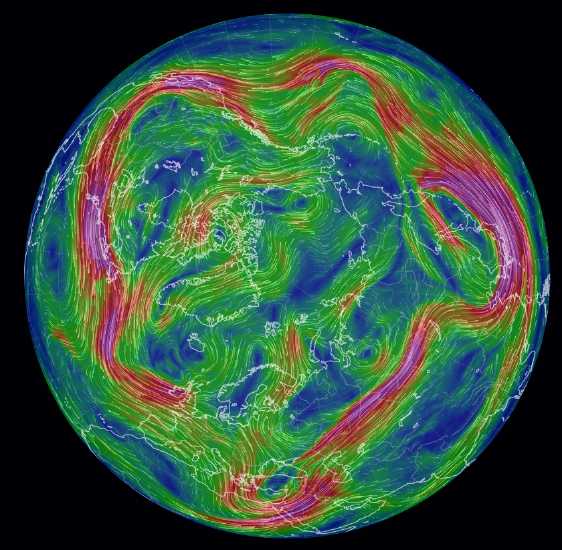 * Much of the
northern hemisphere seems to have been quite cold this
month: Record snowfall in Moscow, cold and snow in Texas/southern USA,
and the -5° around here. Is this attributable to the grand solar
minimum, the ever-extensive jet trails disrupting global wind
circulations, or both? (What is the arctic doing? It hasn't been on the
news. Well, let's see: nullschool.net shows the northern jet stream
bringing air from Alaska down the west coast. Farther south (eg,
Victoria BC) there has been heavy snowfall. From there it loops down
into Mexico exposing most of North America to arctic weather. Other
south-reaching loops go
right down over the Red Sea, and into eastern Asia south of China. Warm
air
is again blowing from the Gulf Stream area of the Atlantic over
Greenland to melt glaciers there. These seem to me like the familiar
"disrupted wind patterns" of recent years, which by themself explains
all the the cold and snow. (I wonder if they're getting snow or more
flooding in Soggy Arabia?) (Hmm... The polar view I took a screen grab
of shows the 3 lobes of the jetstream going far south, but it doesn't
look half as impressive as centering the view on North America.)
* Much of the
northern hemisphere seems to have been quite cold this
month: Record snowfall in Moscow, cold and snow in Texas/southern USA,
and the -5° around here. Is this attributable to the grand solar
minimum, the ever-extensive jet trails disrupting global wind
circulations, or both? (What is the arctic doing? It hasn't been on the
news. Well, let's see: nullschool.net shows the northern jet stream
bringing air from Alaska down the west coast. Farther south (eg,
Victoria BC) there has been heavy snowfall. From there it loops down
into Mexico exposing most of North America to arctic weather. Other
south-reaching loops go
right down over the Red Sea, and into eastern Asia south of China. Warm
air
is again blowing from the Gulf Stream area of the Atlantic over
Greenland to melt glaciers there. These seem to me like the familiar
"disrupted wind patterns" of recent years, which by themself explains
all the the cold and snow. (I wonder if they're getting snow or more
flooding in Soggy Arabia?) (Hmm... The polar view I took a screen grab
of shows the 3 lobes of the jetstream going far south, but it doesn't
look half as impressive as centering the view on North America.)
Hmm, a "live" temperature map shows much of the arctic
other than
the Atlantic ocean from Eastern Greenland to Spitsbergen/Svalbard, is
pretty darn cold. If it's not warmer almost anywhere, that suggests
that the cold is at least partly owing to the overall decrease in solar
output
owing to the grand solar minimum (A.K.A. "GSM").
Lithium-ion Battery Peculiarities
Of course, there's a lot of "voodoo" and peculiarities
with any type of battery. What are we supposed to think about
lithium-ion batteries and their charging? Here we will speak mostly of
open circuit voltages, or charging voltages, rather than voltage under
load.
Their "absolute maximum" voltage is 4.2 V, and they are
said to deteriorate and become dangerous if charged to 4.3 V. And yet,
many chargers pull them right up to 4.2 volts, nothing less. Doubtless
this is the fastest way to charge them, but is it really safe, and
might it contribute to shorter cycle life than keeping the voltage down
a little?
The cells will sit, days later, still at (say) 4.15 V.
Furthermore if some current is drawn off them for a short time, they
will still pop back up to (say) 4.13 V when the load is removed,
suggesting that they are holding at least somewhat more energy at 4.15
V than at (say) 4.0 volts. This is in contrast to lithium-iron
phosphate, which can also be charged as high as 4.2 volts, but which
will quickly drop to 3.33 V or so and stay there as soon as any
significant load has been drawn from it.
And yet this "typical" graph shows "100% charge" at a
little under 4.0 volts. It would seem that most of the charge is gained
and lost between 3.5 and 3.95 volts. Is the energy above 4.0 volts,
then "greater than 100%" charge? I think we might assume that.
But here is a graph of charging current versus state of
charge, holding the cell at 4.2 volts for most of the charge cycle,
that shows 100% being when it stops drawing current at that voltage.
Connecting the stacks of 10 lithium-ion cells in my solar
back-up power system, I set the voltage to stop at about 39.5 (3.95 V
per cell). First of all it seemed about right. Even if that isn't 100%
charge it must be well over 95%. I don't need an ultimate 100% charge,
still less that it be "ASAP", when they're on charge all day every day.
The second reason is more problematic: If the PowMr charge
controller should be reset and senses 40 volts or more, it will assume
it must be a 48 volt system instead of 36 volts, and throw on full
charge in an attempt to raise the 36 volts to 48. That is, it will
attempt to blow up the batteries and burn the house down. This one
ill-conceived feature makes it a potentially dangerous unit. It was
nice to find a charge controller that works for a 36 volt system, but
the "auto voltage sense" is a very bad idea, and 40 volts is too low
for safety with a 36 volt system. Surely 44 volts would be a much safer
choice. Better still, the user should be able to manually set and "lock
in" the intended operating voltage. (It tried to fry my NiMH cells a
couple of times owing to this. Luckily I was suspicious and caught it.
Then I turned them down to 39 volts instead of 40.5.)
Hopefully with this particular setup, the balance charger
wouldn't let the lithium-ion cells be overcharged, but I wouldn't want
to rely on it. I would have set it to about 39.5 volts anyway. I want
the cells to last as long as possible rather than to charge as fast as
possible and hold a very few percent extra charge.
Electricity
Storage
(Batteries)
Turquoise Battery Project: Long lasting, low cost, high energy
batteries
Some More Theory
[9th] A video on a silver-zinc battery experiment (by "NurdRage", youtube) showed oxygen
and hydrogen overvoltage potentials as:
Silver: +.91 V
Nickel: +.56 V
Carbon: +.95 V
Zinc: -.77 V
Nickel: -.28 V
The zinc figure seems puzzling, since the actual charge on
the zinc is something like -1.24 volts. According to that, the zinc
should just bubble hydrogen and discharge itself. I suspect it's the
figure for acidic solution rather than alkaline.
New Cylindrical Cell
I asked someone about making copper sheet metal into cans,
and he was dubious. He said that needed super precision punches and
dies with very fine tolerances. I put my juicy ideas for nice, thin,
solid copper battery cans on hold.
He did suggest one could put a pipe on a lathe and bend one end in to
the center to make a solid bottom involving no other metal but the
copper. Well, at least if that wouldn't leak it would be solid copper.
The immediate next step seemed to be to coat the inside of
one or both existing [silver soldered bottom] copper cans with zinc.
Electroplating made a loose powdery coating of dendrites, many sections
of which apparently would easily passivate and so in total there would
be much less energy than for the amount of zinc employed. Probably
that's a reason my cells had lower capacity than expected in 2019/2020.
A solid layer of zinc such as Peter made by dipping the copper in
liquid zinc is better.
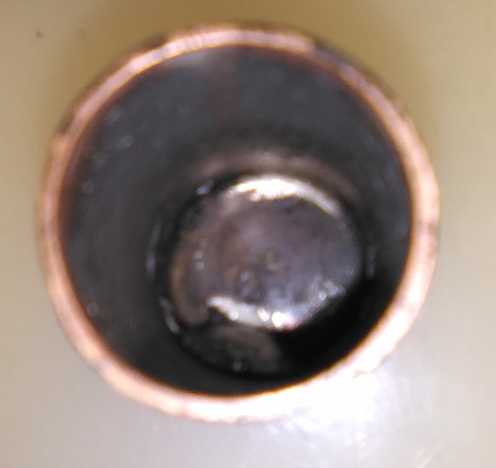 The first thing I tried early in the month was putting some tin solder
flux on the inside of a can, wrapping a sheet of zinc inside the can,
and heating it with a propane torch. Hopefully the zinc would melt onto
the copper. Basically it made a mess. There was a bit of zinc adhered
in spots, but most of it became a loose blob in the bottom of the can.
The first thing I tried early in the month was putting some tin solder
flux on the inside of a can, wrapping a sheet of zinc inside the can,
and heating it with a propane torch. Hopefully the zinc would melt onto
the copper. Basically it made a mess. There was a bit of zinc adhered
in spots, but most of it became a loose blob in the bottom of the can.
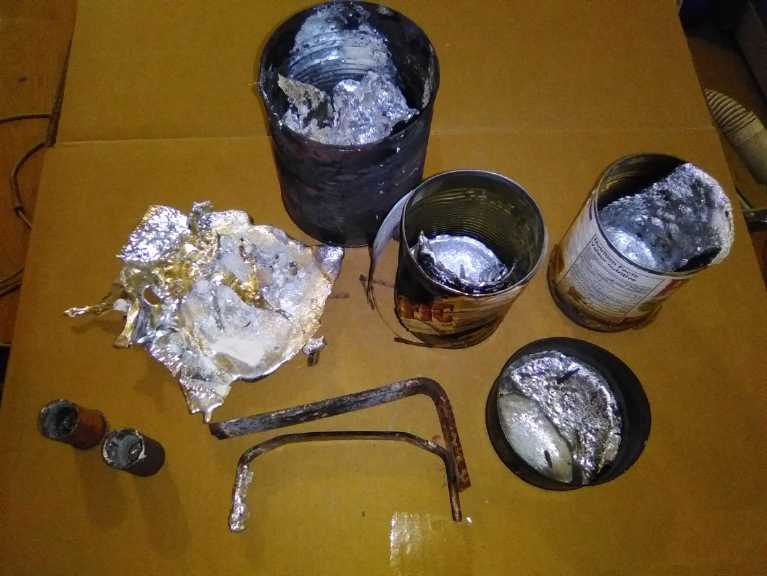 On about the
23rd I tried coating the inside of the cans with solder flux paste with
some borax mixed in. I got a couple of old boat zincs and put them in a
food can. I heated this in my mini-kiln for 1/2 an hour. (It's amazing
how some ugly old pitted, oxidized, powdery looking sacrificial boat
electrodes turn into shiny, silvery liquid zinc!)
On about the
23rd I tried coating the inside of the cans with solder flux paste with
some borax mixed in. I got a couple of old boat zincs and put them in a
food can. I heated this in my mini-kiln for 1/2 an hour. (It's amazing
how some ugly old pitted, oxidized, powdery looking sacrificial boat
electrodes turn into shiny, silvery liquid zinc!)
 I filled the
copper cans with zinc. I went to pour it out but it had already
hardened. So I put it all back in the kiln for a few minutes and
repeated. I got the zinc out of the battery cans, but the coating was
still ugly. Just as I poured the rest of the zinc into other food tins
(of course not made of tin!) I remembered from youtube that
most people used muffin trays. The muffin cups have sloped edges. Later
I had to snip and rip the cans to pieces to get the zinc out.
I filled the
copper cans with zinc. I went to pour it out but it had already
hardened. So I put it all back in the kiln for a few minutes and
repeated. I got the zinc out of the battery cans, but the coating was
still ugly. Just as I poured the rest of the zinc into other food tins
(of course not made of tin!) I remembered from youtube that
most people used muffin trays. The muffin cups have sloped edges. Later
I had to snip and rip the cans to pieces to get the zinc out.
Later I thought about galvanized metal in general - bolts
and things. Those seem to get a good thick coating of zinc. Galvanized
bolts have a coating thick enough that they need special nuts. It
occurred to me that perhaps instead of heating up the copper cans I
should leave them cold, then dip them and empty them very rapidly. The
cold copper might collect a thicker coating of zinc: it would thicken
and freeze onto the copper quickly, before it could mostly run off.
Just a thought that might work.
However, my next idea was
to try brush plating. In that, one wraps an anode (here zinc) with a
cloth and dips it in the electrolyte solution (zinc chloride), and
connects a positive voltage to the anode negative to the surface to be
plated. Then one brushes the cloth covered wand across the that. The
metal (zinc) transfers across from the wand, through the electrolyte
soaked cloth, onto the surface. It would surely be very slow to get
much of a layer, but I hoped that unlike regular dip electroplating it
might make a nice solid deposit without powdery dendrites.
I had intended to try it the next day but I had to go into
town, then the weather turned nice and I had fairly urgent outdoor jobs
to do. Then a neighbor cut down some trees and was going to burn them
in a pile. I need firewood for next winter, so I cut and hauled it.
(Prepping the firewood trailer with a low tire, the lawn tractor with a
"new" lithium battery so it would start reliably, and the chain saw
took more time than the actual work.) There went another afternoon. I
really must get the rest of the siding on the walls of the "cottage".
(See "month in brief") Next month I'll have to start planting seedlings
for the garden. It's getting frustrating that I seem to have so little
time for green energy projects over an increasingly lengthy period of
time.
[28th] I decided to try it on a flat scrap of copper. I
used 1.5 volts. On the first stroke the silvery color appeared on the
copper. After a few more it occurred to me to weigh the piece so I
would know how much zinc had been added. (Couldn't be much zinc yet, I
trust.) It was 3.50 grams. After a couple of minutes of rubbing it was
3.55. Was that anything at all or just imprecision in the readings?
After a couple more minutes it was 3.60 ... then 3.60 ... then 3.65 ...
then 3.70. Apparently the plating was getting thicker. The
highest currents were obtained with the brush laid down flat - with the
most surface area in contact. (Let's see... .2g @ .82 AH/g = .164 AH.
More than zero, anyway!)
If I left the brush sitting on one spot, that area turned
flat black. Rubbing it back and forth kept it a shiny silver-gray. A
look with the microscope verified that gray areas were relatively
smooth, while black ones were rough and dendrites were formed or
forming. I went one more round (3.75g!) and found that the more
vigorously I rubbed, the more silvery and smooth the coating became.
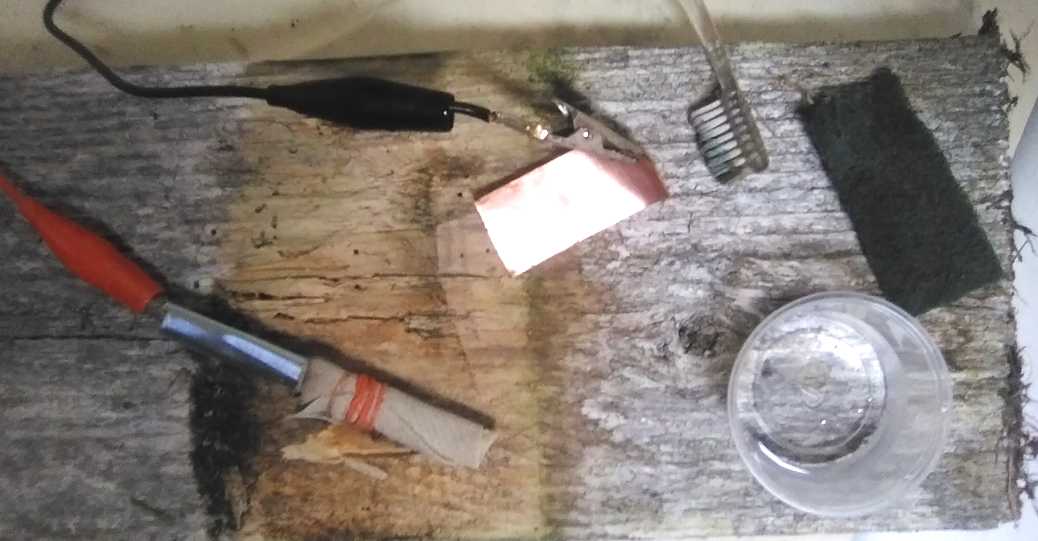 The setup: Thin copper sheet (with negative
leed attached) was cleaned with scotchbrite and with
toothpaste/toothbrush.
The setup: Thin copper sheet (with negative
leed attached) was cleaned with scotchbrite and with
toothpaste/toothbrush.
Zinc "wand" (positive leed) was wrapped with a cloth & rubber band,
then dipped in the zinc chloride electrolyte.
 A little rubbing with the wetted wand started
imparting a coating of zinc on the copper
A little rubbing with the wetted wand started
imparting a coating of zinc on the copper
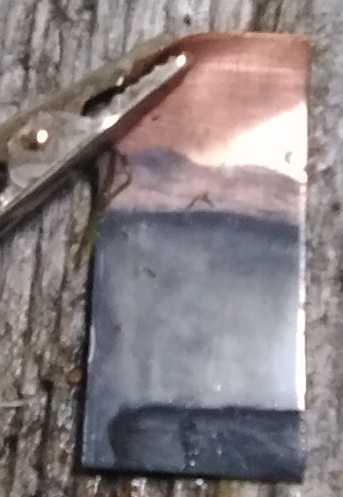
If the brush was allowed to sit on the zinc without moving,
a black area of dendrites would quickly form
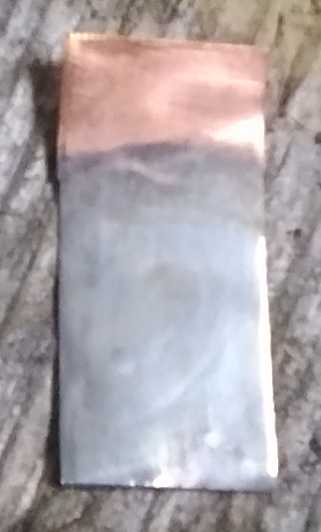
Continuous rubbing made a smooth, shiny zinc coating
- but only very slowly. In quite a few minutes of
rubbing I got just 1/4 gram of zinc onto the copper.
Tricky stuff, zinc! If there was some way to keep rubbing
it inside a battery as it charged, the dendrite problem could easily be
solved. Here, while I didn't mind how long it might take to build up a
good initial layer of zinc in an automatic process, it was obvious
brush plating by hand would be very tedious. And the more so inside a
cylinder.
How about a slowly spinning cloth with a piece of zinc for
an anode axle? If it fit right it could continuously wipe the inside of
the can as it plated it. But now I'm talking about potential production
processes again!
For now... I cleaned out the insides of the cans as best I
could. HCl dissolved out the little zinc that had plated on. I brush
plated the inside of one can for about 40 minutes. It surely could have
used way more, but my back started hurting and that was about all for
me. According to last month, this can had weighed 29.40g before
plating. Now it was 30.40g, so I had put on about a gram (.82
amp-hours) of zinc. It wasn't anything like as smooth as on the flat
piece, but I decided it was workable. But it didn't seem like much
capacity. Maybe I should do another session and add some more zinc?
Well, that'll be in March.
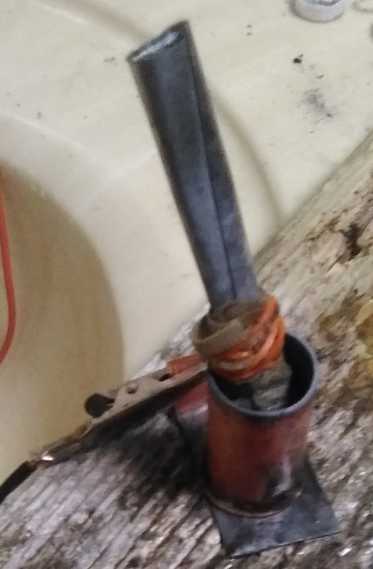 I rubbed the wand up and down as I turned the
can around and around.
I rubbed the wand up and down as I turned the
can around and around.
In order to keep electrical contact while turning the can, I attached
the
negative leed to the same piece of sheet copper and set the can on it.
 I remembered I had a zinc rod, and I did get
somewhat
I remembered I had a zinc rod, and I did get
somewhat
higher plating currents using it for a wand; up to 3 amps.
I had to use a battery clamp alligator clip on the fat rod.
 After a while of rubbing there was a thin (and
for
After a while of rubbing there was a thin (and
for
some reason somewhat bumpy) coating of zinc in the can.
40 minutes got it up to a gram, but it could easily use several grams.
I really must find something better for a camera than this new cellfone.
http://www.TurquoiseEnergy.com
Haida Gwaii, BC Canada






 So once again a construction project took priority. The
cold weather made difficulties and delays. But finally I had made up
three wooden frames with chicken wire, 16 feet long by 6-1/2 feet tall,
with hooks on one end and eyes on the other. Thus they could be
assembled into a triangular fenced-in area. It was of course hard to
get in and out of.
So once again a construction project took priority. The
cold weather made difficulties and delays. But finally I had made up
three wooden frames with chicken wire, 16 feet long by 6-1/2 feet tall,
with hooks on one end and eyes on the other. Thus they could be
assembled into a triangular fenced-in area. It was of course hard to
get in and out of. Next I made a short fourth side with a door in it. The
door having pins rather than hinges opens in either direction. Then I
did some more work on the 1/2 finished
chicken coop and by the 23rd had 2 nesting boxes on one end. (Still no
proper door! I have to unscrew a plywood wall to gain good access for
cleaning etc.)
Next I made a short fourth side with a door in it. The
door having pins rather than hinges opens in either direction. Then I
did some more work on the 1/2 finished
chicken coop and by the 23rd had 2 nesting boxes on one end. (Still no
proper door! I have to unscrew a plywood wall to gain good access for
cleaning etc.) * Much of the
northern hemisphere seems to have been quite cold this
month: Record snowfall in Moscow, cold and snow in Texas/southern USA,
and the -5° around here. Is this attributable to the grand solar
minimum, the ever-extensive jet trails disrupting global wind
circulations, or both? (What is the arctic doing? It hasn't been on the
news. Well, let's see: nullschool.net shows the northern jet stream
bringing air from Alaska down the west coast. Farther south (eg,
Victoria BC) there has been heavy snowfall. From there it loops down
into Mexico exposing most of North America to arctic weather. Other
south-reaching loops go
right down over the Red Sea, and into eastern Asia south of China. Warm
air
is again blowing from the Gulf Stream area of the Atlantic over
Greenland to melt glaciers there. These seem to me like the familiar
"disrupted wind patterns" of recent years, which by themself explains
all the the cold and snow. (I wonder if they're getting snow or more
flooding in Soggy Arabia?) (Hmm... The polar view I took a screen grab
of shows the 3 lobes of the jetstream going far south, but it doesn't
look half as impressive as centering the view on North America.)
* Much of the
northern hemisphere seems to have been quite cold this
month: Record snowfall in Moscow, cold and snow in Texas/southern USA,
and the -5° around here. Is this attributable to the grand solar
minimum, the ever-extensive jet trails disrupting global wind
circulations, or both? (What is the arctic doing? It hasn't been on the
news. Well, let's see: nullschool.net shows the northern jet stream
bringing air from Alaska down the west coast. Farther south (eg,
Victoria BC) there has been heavy snowfall. From there it loops down
into Mexico exposing most of North America to arctic weather. Other
south-reaching loops go
right down over the Red Sea, and into eastern Asia south of China. Warm
air
is again blowing from the Gulf Stream area of the Atlantic over
Greenland to melt glaciers there. These seem to me like the familiar
"disrupted wind patterns" of recent years, which by themself explains
all the the cold and snow. (I wonder if they're getting snow or more
flooding in Soggy Arabia?) (Hmm... The polar view I took a screen grab
of shows the 3 lobes of the jetstream going far south, but it doesn't
look half as impressive as centering the view on North America.) The first thing I tried early in the month was putting some tin solder
flux on the inside of a can, wrapping a sheet of zinc inside the can,
and heating it with a propane torch. Hopefully the zinc would melt onto
the copper. Basically it made a mess. There was a bit of zinc adhered
in spots, but most of it became a loose blob in the bottom of the can.
The first thing I tried early in the month was putting some tin solder
flux on the inside of a can, wrapping a sheet of zinc inside the can,
and heating it with a propane torch. Hopefully the zinc would melt onto
the copper. Basically it made a mess. There was a bit of zinc adhered
in spots, but most of it became a loose blob in the bottom of the can. On about the
23rd I tried coating the inside of the cans with solder flux paste with
some borax mixed in. I got a couple of old boat zincs and put them in a
food can. I heated this in my mini-kiln for 1/2 an hour. (It's amazing
how some ugly old pitted, oxidized, powdery looking sacrificial boat
electrodes turn into shiny, silvery liquid zinc!)
On about the
23rd I tried coating the inside of the cans with solder flux paste with
some borax mixed in. I got a couple of old boat zincs and put them in a
food can. I heated this in my mini-kiln for 1/2 an hour. (It's amazing
how some ugly old pitted, oxidized, powdery looking sacrificial boat
electrodes turn into shiny, silvery liquid zinc!)


